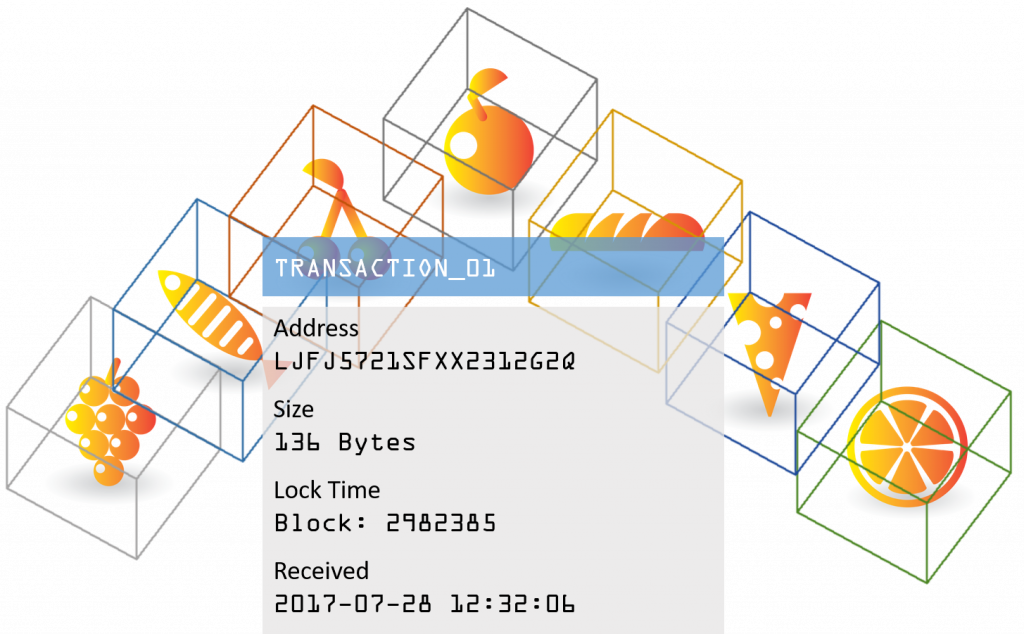Blockchain is one of the newest buzzwords making a splash in the tech world. Most famously, blockchain is associated with so-called crypto-currencies like Bitcoin and Ethereum. It turns out, however blockchain technology can prove useful in many fields of endeavor. The food sector may be one area where blockchain technology will prove to be extremely beneficial. Megan Ray Nichols (@nicholsrmegan) explains, “Blockchain can help improve the transparency and management of the food supply chain. It’s definitely needed.”[1]
What is blockchain?
Sometimes referred to as distributed ledger or hyperledger technology, blockchain is a digital ledger (i.e., a database) that can be used by multiple users, provides real-time data visibility and, more importantly, in addition to availability, blockchain provides immutability, privacy, security, and other critical business requirements. Toby Gooley, Editor of Supply Chain Quarterly, explains, “[Blockchain] is basically a database that runs across a global network of independent computers. It serves as an open ledger, where every transaction on the network is recorded and available for all participants to see and verify. By providing a common view, a blockchain eliminates the need to transfer information between organizations through such things as e-mails, spreadsheets, and direct electronic connections, and it helps to reconcile any differences in data between suppliers and customers. Importantly, the database is immutable; in other words, it cannot be changed without all participants’ agreement.”[2] When blockchain is used, explain Goldman Sachs’ analysts, “The transaction information is recorded and shared with the other computers in the blockchain network. On the network, the record is combined with other transactions into a block — like a traditional computer database. Each transaction is time-stamped. When a block is complete, it also gets its own time stamp. So all information is sequential, which helps avoid duplicate entries.”[3]
Blockchain and the global food chain
“The global food industry is worth trillions of dollars,” writes Cindy Huynh.[4] The global food industry is also essential to maintain the health and well-being of the world’s population. “Unfortunately,” Huynh laments, “where there are opportunities, there will be those quick to take advantage.” One way nefarious actors take advantage of the global food chain is through fraud. Huynh defines food fraud as: “Purposely altering, misrepresenting, mislabeling, substituting or tampering with any food product at any point along the farm to table food supply chain.” Fraud is just one area where the global food chain can be improved using blockchain technology.
Food fraud
“Not only does fraud in the food industry have economic costs,” Huynh writes, “it can lead to public health and brand reputation risks. Unfortunately, the current approach to prevent fraud in the food industry is failing. The systems built were originally made to ensure food quality but didn’t foresee sophisticated fraud practices in the supply chain. Criminals are therefore outsmarting the current procedures in place. Blockchain technology, however, can trace long and complicated supply chains. Its transparency, speed, security and user collaborations allow quick and easy traceability of products. Global brands such as Nestle and Walmart are therefore testing blockchain technology with great success, according to Reuters. Blockchain technology has great potential to fight the billion dollar fraud issue and transform the food industry.”[4]
Fresh food
Ken Cottrill, co-founder of Chain Business Insights, notes, “Blockchain technology is emerging as a key enabler as the industry looks to reshape supply chains to meet customers’ changing demands.”[5] What are grocery customers demanding? Fresh food. Annie Gasparro (@Annie_Gasparro) reports, “Grocery stores are choosing to give better play to fresh food, prepared hot meals, and items from local upstarts more in favor with increasingly health-conscious consumers.”[6] She adds, “The shift in shopper preferences started several years ago.” According to Cottrill, “Blockchains have a key role to play in supporting the focus on these markets. The technology — with its shared ledger and immutable data architecture and its ability to run smart contracts — is being developed and tested in three critical areas of the food supply chain.” Those areas are:
- Sustainable agriculture: “The agricultural industry is harnessing the explosive growth in Internet of Things technology by using arrays of sensors to monitor the usage of materials such as pesticides and fertilizers. Blockchains’ interface with sensor networks to provide farmers with the timely, secure information they need to manage growing operations both profitably and sustainably.”
- Supply chain transparency: “In addition to information on the raw materials that go into natural food products, blockchains’ immutable record of every transaction in the farm-to-fork supply chain is paramount. Relevant details are made available to discerning consumers via smart labels paired with apps running on mobile devices.”
- Safety monitoring: “Every year, spoiled foods cause thousands of people in the U.S. to be hospitalized (and some even die). A blockchain’s ledger can be used by retailers to pinpoint the cause of these problems quickly, and to recall tainted natural food products in order to limit consumer impact and maintain overall supply chain health.”
Cottrill adds, “Such applications will increase in importance as the market for fresh foods continues to evolve.”
Food security
Food security is about feeding the growing global population now and in the years ahead. In order to achieve this goal, we need to protect food supplies and reduce food waste. Blockchain can help by improving visibility and traceability of food products. Nichols observes, “The world’s population continues to grow, and it’s expected to reach 10 billion by 2050. In food requirements, that means we’ll need to be increasing food production by as much as 70% to keep up. This puts a demand on the food supply chain to evolve and become more efficient, more accurate and more reliable. … Blockchain can help achieve better transparency in and management of the food supply chain.” She suggests three ways blockchain technology can help:
1. Preventing Foodborne Outbreaks, Enabling Fresher Goods. “[Blockchain] can be used to track a product’s journey from farm to store shelves. The goal is to create a more transparent deployment and transportation process so that interested parties can see exactly when and where certain foods might become contaminated. Tracking this information will achieve a couple of things. For starters, public health officials, suppliers and management teams can help limit and prevent contagions from spreading. After the detection of Salmonella, for instance, they could mark all related goods as a risk and stop both stores from selling them and consumers from buying faster than ever before. Second, it will help identify problematic systems and processes, hopefully cutting down on the risk of contamination in the future. … In other words, suppliers and retailers will use blockchain to keep food fresh.”
2. More Accurate Inventory Tracking for Distributors. “Unexpected shortages pose significant challenges to the food supply chain. A variety of external factors can contribute to a supply block, including inclement weather, poor soil, insect infestations, equipment failures and much more. When this happens, distributors are left to pick up the slack, but sadly, they often can’t do much to fix the problem. Blockchain technologies, however, make the supply chain more transparent, which helps distributors get the information they need to address shortages. Through the use of blockchain, they’ll know exactly how much supply is available and what they need to do to ramp up their offerings.”
3. Transparent Safety Protocols. “The food supply chain is lengthy [and] it’s hard to keep track of what every party is doing, where problems exist and what improvements can be made. … Blockchain can completely alter and disrupt this for the better. … Blockchain can offer more than just peace of mind. It can help organizations perfect the entire process, improving safety for consumers and even enhancing the freshness or quality of the products provided.”
Another way blockchain can enhance food security is by monitoring illegal activity. Candice Visser and Quentin Hanich, researchers from the University of Wollongong, report, “In a significant development for global fisheries, blockchain technology is now being used to improve tuna traceability to help stop illegal and unsustainable fishing practices in the Pacific Islands tuna industry.”[7] They concludes, “Blockchain technology is just starting to change the way business is done. If it delivers on its promise of supply-chain transparency, it will be a great tool to help ensure that industries — including the tuna industry — are doing the right thing.”
Footnotes
[1] Megan Ray Nichols, “Blockchain Improves Visibility In the Food Supply Chain,” Food Safety Tech, 5 January 2018.
[2] Toby Gooley, “If you don’t know what blockchain is, start studying,” Supply Chain Quarterly, 27 June 2017.
[3] Staff, “Blockchain — The New Technology of Trust,” Goldman Sachs, 2017.
[4] Cindy Huynh, “How Blockchain can Improve the Food Industry,” Coinsquare, 10 January 2018.
[5] Ken Cottrill, “How Blockchain Technology Will Underpin the Fresh Food Sales Boom,” Distributed, 20 June 2017.
[6] Annie Gasparro, “Big-Name Food Brands Lose Battle of the Grocery Aisle,” The Wall Street Journal, 30 April 2017.
[7] Candice Visser and Quentin Hanich, “How blockchain is strengthening tuna traceability to combat illegal fishing,” The Conversation, 21 January 2018.





